
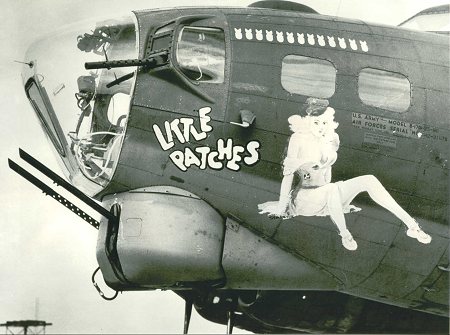 History:
“Little Patches” (42-31678) B-17G-25-BO was delivered by Ferry Command, to
Bassingbourn in late January 1944.Originally assigned to the 324th
BS (id: DF-L), she received heavy flak damage two weeks later on a mission to
Frankfurt, Germany, was repaired with a lot of metal patches to the nose area,
and then was named “Little Patches” by Lt. William Major.
History:
“Little Patches” (42-31678) B-17G-25-BO was delivered by Ferry Command, to
Bassingbourn in late January 1944.Originally assigned to the 324th
BS (id: DF-L), she received heavy flak damage two weeks later on a mission to
Frankfurt, Germany, was repaired with a lot of metal patches to the nose area,
and then was named “Little Patches” by Lt. William Major.
In early May 1944 she was re-assigned to the 401st BS (id: LL-L), where she stayed the remainder of the war. She finished her career with over 100 sorties flown, as well as safely harbored 34 different crews and never lost a crewman. She also returned north of Berlin, a target on eight previous missions, on May 8th 1945 and collected RAF/POW’S and returned them home to England. Little Patches returned to the United States on 6/11/45. Retired from service at Kingman, Arizona 12/7/45 for salvage, along side countless other B-17’s.
|
THE KIT |
What can I say; Monogram’s B-17 kit is a classic! And is also the only 1/48 scale B-17 you can get, most enjoyed by all builders of this kit. I found however it does have weakness’ to detail as most kits do, and with a little help from update sets and many hours of research, it can become a gem. Monogram also has an excellent variety of B-17 variations to choose from, from the early “f” to late “g”, standard tail or the Cheyenne tail turret, it is by far probably one of the most optional kits you could ever build.2 kits were used in the making of this diorama, the basic “G” model and the Promodeler “G” to obtain the maximum detail and accuracy I could get in a single subject, where I will describe more in depth below.
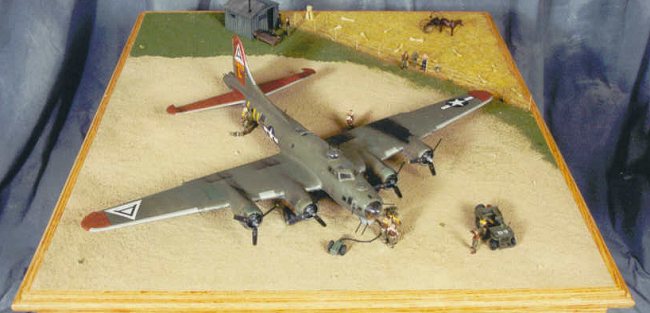
|
CONSTRUCTION |
I started this kit early in the winter of 1999, and finished “Little Patches” on February 26 2002. My first goal was to find a subject that I wanted to portray as a diorama when finished, and spent numerous hours searching books, the web, and articles until I was flipping through the pages of Squadron’s B-17 in action and on the back cover, was what I was looking for!
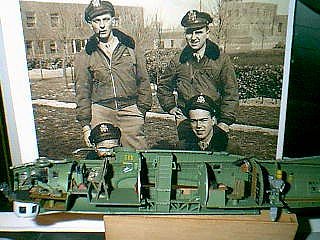 The kit itself I found to be
extremely well done, but as stated earlier it had a lot of places that needed
a lot of attention. Such areas were the tail gunners position, ball turret
frame, cockpit, guns, and waist windows. First off was the fuselage halves,
and trust me there’s a lot of little stuff in them. Modelmaster paint was used
throughout this entire project, as I have found it very easy to work with, as
well as mix and airbrush. The entire fuselage was painted olive/chrome where
naturally found inside a B-17, as well as detail sets added to help with
missing or poorly done area’s in the aircraft. The tail gunner’s position was
completely reworked down to seat belts, new seat, blast shield, and oxygen
canisters and re-worked twin machine guns complete with ammunition boxes and
ammo belts.
The kit itself I found to be
extremely well done, but as stated earlier it had a lot of places that needed
a lot of attention. Such areas were the tail gunners position, ball turret
frame, cockpit, guns, and waist windows. First off was the fuselage halves,
and trust me there’s a lot of little stuff in them. Modelmaster paint was used
throughout this entire project, as I have found it very easy to work with, as
well as mix and airbrush. The entire fuselage was painted olive/chrome where
naturally found inside a B-17, as well as detail sets added to help with
missing or poorly done area’s in the aircraft. The tail gunner’s position was
completely reworked down to seat belts, new seat, blast shield, and oxygen
canisters and re-worked twin machine guns complete with ammunition boxes and
ammo belts.
The next area I found that needed attention was the ball turret position. I decided to re-work the original cradle supplied with the kit, and stripped it and added ammo canisters, ammo chutes, new oxygen system. This seemed to really bring this area to life and bring a more realistic area to this position in plane. The next area was the radio operator where small detail and research came in handy. The cockpit was next and a lot of extra detail went into getting this area just right. The seat were redone to include the plywood back boards with map holders, seatbelts were added, as well as a fully reworked bombardier and navigator station, complete with Norton bomb sight, ammo chutes, belts, boxes. Front chin turret was also redone to include outside inspection areas (2-small Plexiglas viewing areas when chin turret is turned starboard) as well as ammo belts. This was the majority of the interior, not going to list every little thing but you can get the idea of what I was after as far as detail. Time to close it up and found that joining the fuselage halves were a little tricky, but fit well at joints with little putty work needed.
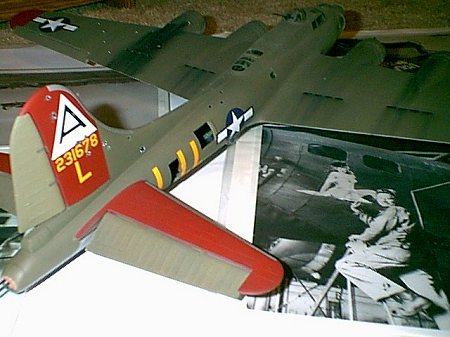 I set the fuselage
aside and focused on the wings and tail sections. I decided that detail was my
main goal here and carefully studied photo’s and illustrations of the wings
and tail surfaces. First thing I saw that needed redone was the air/exhaust
vent behind each engine on the top portion of each wing. With a little help
from my trusty Dremel tool, I thinned down each little vent wall and opened it
up, I do not recommend doing this unless you have a lot of detail experience,
as this is extremely hard and takes a lot of time and patience without ruining
your wings! After this step was complete, the turbo chargers were removed so
that the Verlinden resin ones could be added later on. I also added screens to
leading edge wing intakes, as well as cut out flap areas for Paragon flap set,
and other control surfaces on wings, tail section and rudder. Next was to join
wings/tail sections to the fuselage, which to my surprise went extremely well
expecting poor matches to fuselage and tail. With little putty and some
sanding, it was a beautiful fit!
I set the fuselage
aside and focused on the wings and tail sections. I decided that detail was my
main goal here and carefully studied photo’s and illustrations of the wings
and tail surfaces. First thing I saw that needed redone was the air/exhaust
vent behind each engine on the top portion of each wing. With a little help
from my trusty Dremel tool, I thinned down each little vent wall and opened it
up, I do not recommend doing this unless you have a lot of detail experience,
as this is extremely hard and takes a lot of time and patience without ruining
your wings! After this step was complete, the turbo chargers were removed so
that the Verlinden resin ones could be added later on. I also added screens to
leading edge wing intakes, as well as cut out flap areas for Paragon flap set,
and other control surfaces on wings, tail section and rudder. Next was to join
wings/tail sections to the fuselage, which to my surprise went extremely well
expecting poor matches to fuselage and tail. With little putty and some
sanding, it was a beautiful fit!
|
PAINT & DECALS |
Now was time to paint fuselage and wings which were airbrushed in standard olive drab upper surfaces, neutral gray lower, and red tail, all of which I toned down a little to represent a more weathered look of an aged B-17.also the chin turret of “little patches” was another 2 shades lighter of which countless hours of looking, resulted in no known reason for this other than probably a flack hit in nose area and was repainted in a much lighter color of gray. Enamels were used on entire plane, as I have not mastered the acrylic side yet and prefer enamels to which there are pros and cons.
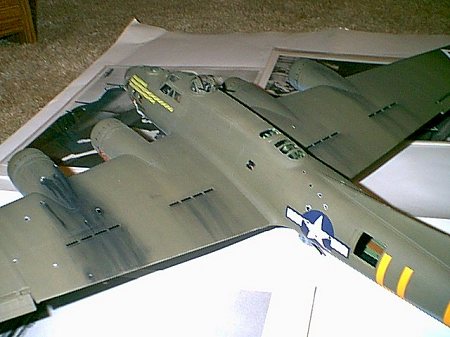 Time for decals,
another problem I found out early is that there are no perfectly accurate 1/48
decals done of this aircraft, many were made but few were historically
correct. A few examples of this are that many have the “triangle A”(also be
sure tail is #2316784,and not 231578.incorrect historical data on the “578”
version) tail decal as solid black with white “A”, this is incorrect, the
triangle is solid white with black “A”.
Time for decals,
another problem I found out early is that there are no perfectly accurate 1/48
decals done of this aircraft, many were made but few were historically
correct. A few examples of this are that many have the “triangle A”(also be
sure tail is #2316784,and not 231578.incorrect historical data on the “578”
version) tail decal as solid black with white “A”, this is incorrect, the
triangle is solid white with black “A”.
Also “little patches” nose art has a very interesting history behind it as well as a lot of incorrect decals made of this also! The correct version of the decal with “little patches” in bubble letters is white letters with black outline (not the yellow letters/never appeared with yellow letters!), also be sure of when you are depicting her during her service, as early on in service little patches displayed a blonde pinup girl (good up to 13 mission markers), she then was in a maintenance fire and sent to sub depot for repairs and upon returning Tony Starcer repainted her as a brunette, which stayed that way the rest of her service!….anyway I started with the decals and finished up with nose art and repainting the pin-up as accurate as possible over the Aeromaster one, which worked very well in this case due to only hair and a few other things that needed attention!
|
FINISHING |
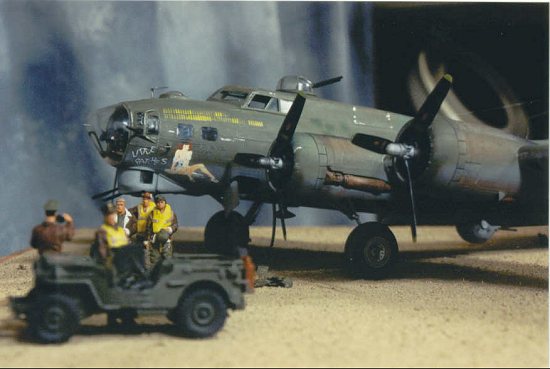 Now
for the small finishing details. I started from the back and worked forwards,
adding a scratch built tail gunner’s sight (ring/bead), metal gun barrels, and
guns canvass rear liner. The waist windows on this particular aircraft were
the solid/not framed Plexiglas. I
found that a round plastic cd storage container works extremely well for
windows in a B-17 (as you would buy them in at a discount store etc.). Also
remember that many B-17g’s did not have a radio operators machine gun in top
glass, such as the case with “Little Patches”…. these were deleted early on in
the war, due to radio operators shooting the tails up and downing or disabling
their own aircraft in some cases! For this you have to borrow a radio
operator’s glass from the Monogram B-17f kit, or the 1/48 “Memphis Belle” also
has this correct glass!
Now
for the small finishing details. I started from the back and worked forwards,
adding a scratch built tail gunner’s sight (ring/bead), metal gun barrels, and
guns canvass rear liner. The waist windows on this particular aircraft were
the solid/not framed Plexiglas. I
found that a round plastic cd storage container works extremely well for
windows in a B-17 (as you would buy them in at a discount store etc.). Also
remember that many B-17g’s did not have a radio operators machine gun in top
glass, such as the case with “Little Patches”…. these were deleted early on in
the war, due to radio operators shooting the tails up and downing or disabling
their own aircraft in some cases! For this you have to borrow a radio
operator’s glass from the Monogram B-17f kit, or the 1/48 “Memphis Belle” also
has this correct glass!
Ball turret is now
reworked complete with seat, reworked metal guns ect. Also top turret is
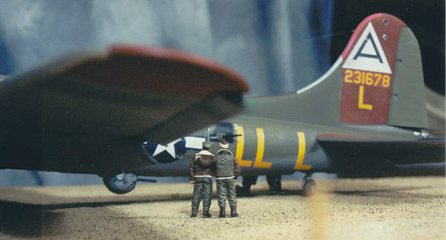 reworked, assembled and given metal barrels/ammo belts. All glass installed
and used a metal-framed front windshield with light plastic glass, (complete
with p.e. metal windshield wipers) so I could display with port window open to
show cockpit details. At this time the chin turret was added along with metal
barrels/flash tubes, and cheek guns. The turbo chargers were painted and put
in proper location, as well as fully detailed radial engines with p.e. wiring
harness’s. I spent several nights weathering this bird and after I was
satisfied with paint, on with the chalks and buffers. These birds were
extremely dirty and one would have a hard time overdoing one of them, as oil
leaks and fires were common issues of B-17’s during the war. Next was adding
the antenna’s, landing gear (Verlinden pieces re-worked for proper ”unloaded”
height) as well as adding photo etched crew access door, rear door, brake
lines, True Details B-17 bulged wheels, as well as a lot of things I am
forgetting to fill in.
reworked, assembled and given metal barrels/ammo belts. All glass installed
and used a metal-framed front windshield with light plastic glass, (complete
with p.e. metal windshield wipers) so I could display with port window open to
show cockpit details. At this time the chin turret was added along with metal
barrels/flash tubes, and cheek guns. The turbo chargers were painted and put
in proper location, as well as fully detailed radial engines with p.e. wiring
harness’s. I spent several nights weathering this bird and after I was
satisfied with paint, on with the chalks and buffers. These birds were
extremely dirty and one would have a hard time overdoing one of them, as oil
leaks and fires were common issues of B-17’s during the war. Next was adding
the antenna’s, landing gear (Verlinden pieces re-worked for proper ”unloaded”
height) as well as adding photo etched crew access door, rear door, brake
lines, True Details B-17 bulged wheels, as well as a lot of things I am
forgetting to fill in.
|
THE DIORAMA |
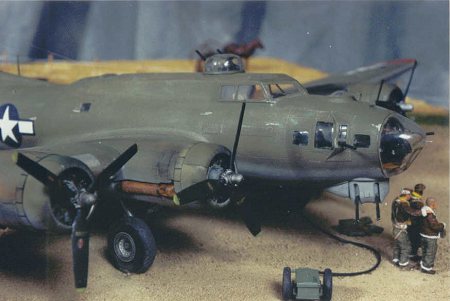 This
solid oak display base measures 32” x 34” and is self-supporting if necessary
by adding legs which mount under display base. I used Woodland Scenics
railroad material for the basic ground/and wheat field behind hardstand. This
diorama is an exact replica (re-created from actual photos) of “Little
Patches” hardstand as it was during the war. Line shack (utility shed) is
scratch built from balsa wood and weathered. Also includes fully detailed
interior which includes, bunk beds, work bench, old metal stove, grinder,
vise, broom, shovel, coffee pot, wood floor, and a tin roof also weathered for
accurate appearance. I also added a switched 6-volt light inside the shack to
illuminate interior, with a glass ½ roof to see inside. The fence is also
scratch built as well as the horse drawn dump rake, constructed from spare
parts, wire, and thread (harnesses). Information for this horse drawn dump
rake was sent to me from a fellow in England, who went to his local museum and
gathered info and photos for my project and sent them to me. All 1/48-scale
figures of farmer, ground crew, and crewman are originally Verlinden figures
with some modifications for proper poses. As a final addition to the diorama a
1/48 scale Bandai Jeep was used as well as a generator cart from Monograms
1/48 WWII airfield accessories. The generators were used as soon as the
bombers landed to keep the batteries and electronics fully charged for the
next mission.
This
solid oak display base measures 32” x 34” and is self-supporting if necessary
by adding legs which mount under display base. I used Woodland Scenics
railroad material for the basic ground/and wheat field behind hardstand. This
diorama is an exact replica (re-created from actual photos) of “Little
Patches” hardstand as it was during the war. Line shack (utility shed) is
scratch built from balsa wood and weathered. Also includes fully detailed
interior which includes, bunk beds, work bench, old metal stove, grinder,
vise, broom, shovel, coffee pot, wood floor, and a tin roof also weathered for
accurate appearance. I also added a switched 6-volt light inside the shack to
illuminate interior, with a glass ½ roof to see inside. The fence is also
scratch built as well as the horse drawn dump rake, constructed from spare
parts, wire, and thread (harnesses). Information for this horse drawn dump
rake was sent to me from a fellow in England, who went to his local museum and
gathered info and photos for my project and sent them to me. All 1/48-scale
figures of farmer, ground crew, and crewman are originally Verlinden figures
with some modifications for proper poses. As a final addition to the diorama a
1/48 scale Bandai Jeep was used as well as a generator cart from Monograms
1/48 WWII airfield accessories. The generators were used as soon as the
bombers landed to keep the batteries and electronics fully charged for the
next mission.
|
CONCLUSIONS |
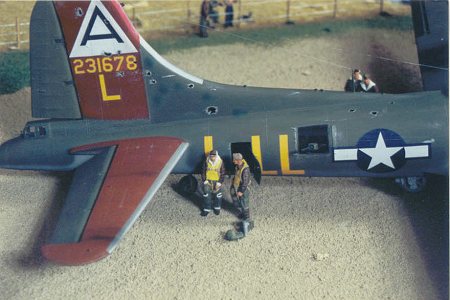 I really
enjoyed this kit a lot and found it very challenging by researching and
studying photos and prints of this B-17G and incorporating them into extra
detail and accuracy for this plane I was depicting. Also would recommend for
anyone (even children) looking for their first big aircraft, as an “out of
box” kit it is very well presented and construction is rather simple and well
drawn out in the instruction sheets, but for others, such as myself who were
after a little more detail, it offers countless areas and items that can
easily be re-worked and updated! Skill rating on this kit is a two or three
which can easily turn into a more experienced level four or five with the help
of detail sets and a lot of scratch building, it all depends on what your
after in the finished product. This has been one of my favorite kits to build
and even has inspired me to begin looking at another B-17 in the near future!
I really
enjoyed this kit a lot and found it very challenging by researching and
studying photos and prints of this B-17G and incorporating them into extra
detail and accuracy for this plane I was depicting. Also would recommend for
anyone (even children) looking for their first big aircraft, as an “out of
box” kit it is very well presented and construction is rather simple and well
drawn out in the instruction sheets, but for others, such as myself who were
after a little more detail, it offers countless areas and items that can
easily be re-worked and updated! Skill rating on this kit is a two or three
which can easily turn into a more experienced level four or five with the help
of detail sets and a lot of scratch building, it all depends on what your
after in the finished product. This has been one of my favorite kits to build
and even has inspired me to begin looking at another B-17 in the near future!
|
REFERENCES |
Squadron/signal publications (#16) Walk Around B-17 Flying fortress,
Squadron/signal publications (#63) B-17 In Action, Squadron/signal
publications (#6561) Fighting Colors “B-17 Flying Fortress” in color, Plane
Names & Fancy Noses (The 91st Bomb Group (HEAVY) by: Ray Bowden. A
lot of extra research was done on the web and web sites covering this aircraft
and the 91st BG.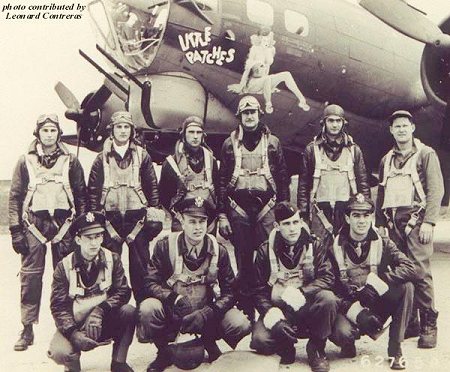
|
A SPECIAL THANKS GOES TO: |
B.L. Deyerle(flew first mission in Little Patches), Ray Bowden, Paul Henritzy (navigator/ Little Patches), Sue & George Shook, Ken Rowley (father was co-pilot/ Little Patches), Wally Foreman, Joe Harlick, Ken Ingignoli , Mike Banta, Paul Chryst, Sam Harris(radio operator /Little Patches), Leonard Contreras, George Parks(original crewman/Little Patches), Jack Paget, George Fredrickson (bombardier /Little Patches), Harold “Hal” Johnson(co-pilot /Little Patches), Sam Newton ( crew /Little Patches),Bernie Rogers (ground crewman/ Little Patches), Steve & Allison Pena (Curators/Tower Museum, England, and to many others, who’s help and dedication to this project made it possible.
Copyright ModelingMadness.com